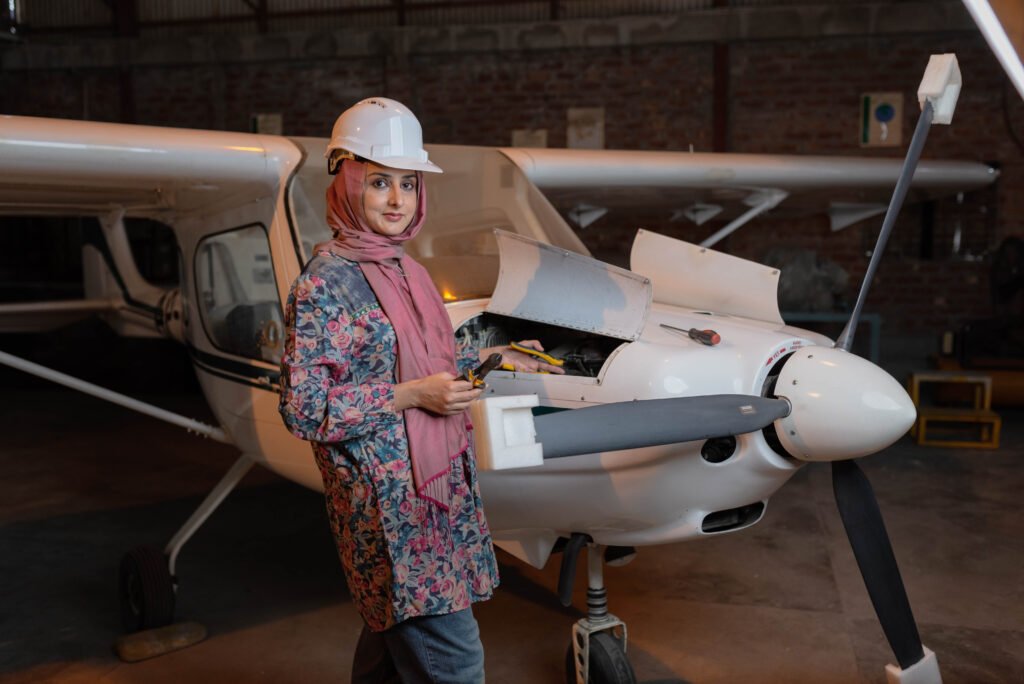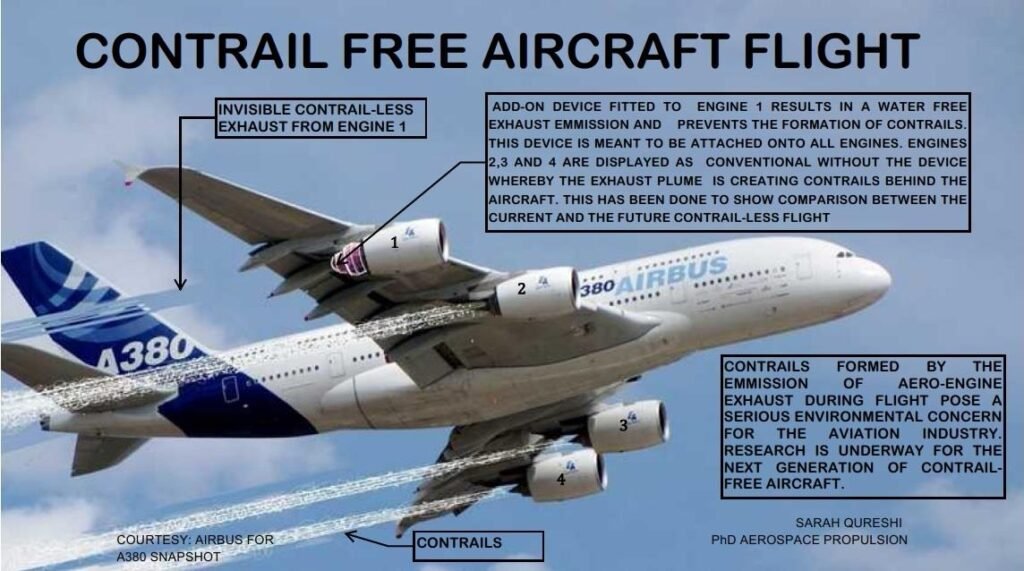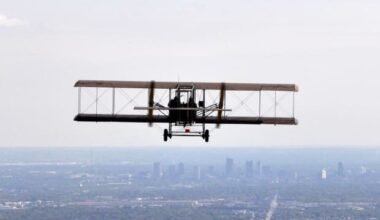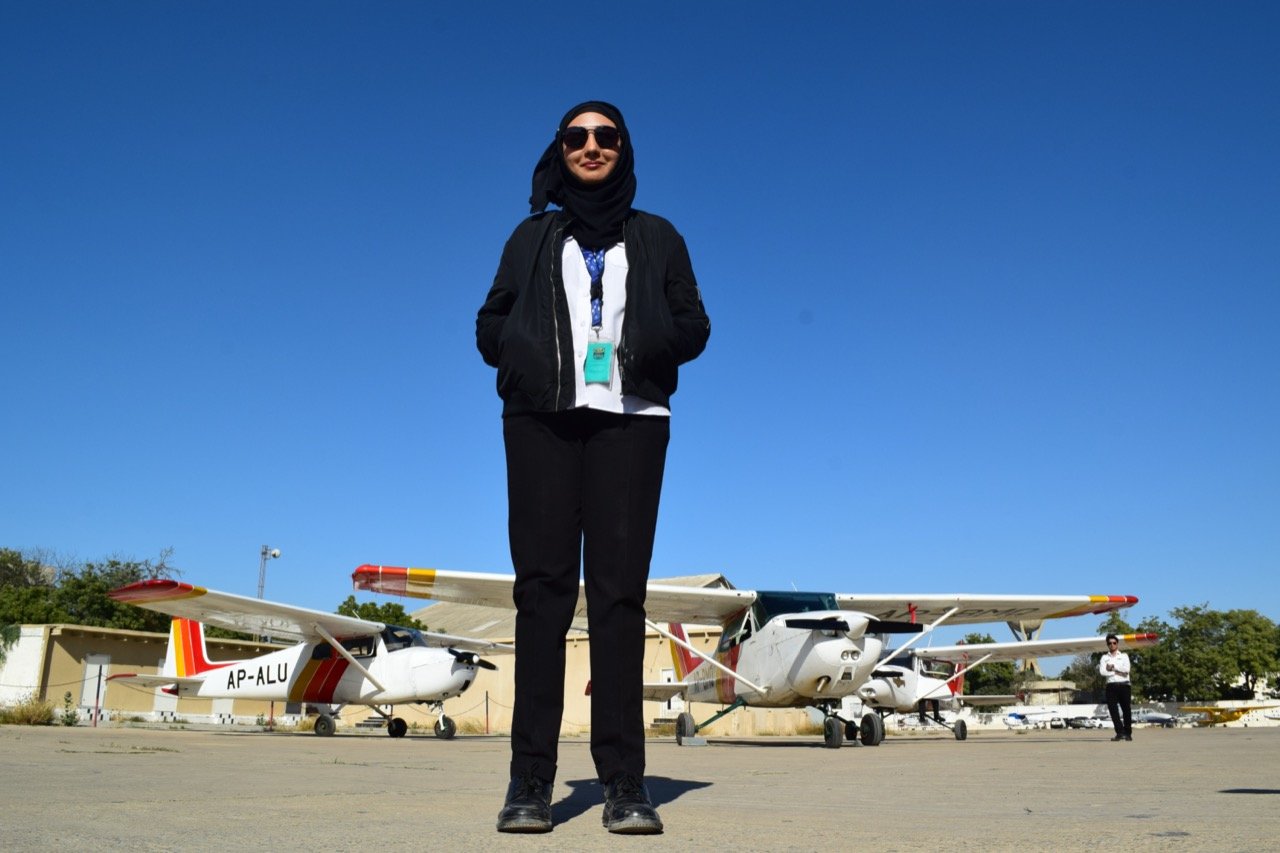In our weekly series of Humans of Aviation, Meet Dr. Sarah Qureshi, a rising entrepreneur from Pakistan, has developed a way to make aviation sustainable. Dr. Qureshi has developed a technology to reduce the carbon footprint left by the contrails of airliners.
Aviation and Environmental Sustainability
Recent trends indicate that numerous environmental challenges, including contrails, are now redefining the aviation industry. A contrail is a word coined from condensation trail. Contrails appear as the white trailing line of vapor visible behind an aircraft during flight.
How are Contrails formed?
Contrails are created at high altitudes (around 10000 m) during flight by the atmospheric condensation of the supersaturated water vapor present in the emissions of an aircraft engine as a combustion by-product once the water vapor is released from the engine exhaust. The formation of contrails is a function of the altitude and the temperature and pressure of the exhaust gas released from the aircraft and entering the cold atmosphere.

The Science behind Condensation Trail
The combustion products of any hydrocarbon fuel are carbon dioxide and water. According to the emission index of water, 1.25 kg of water is produced for every 1 kg of kerosene fuel burn. When H2O and CO2 are created in an aero-engine combustor due to fuel burn, they are in the gaseous form. However, after some cooling, the water coagulates to form condensation nuclei of the order of 0.2 microns.
When the exhaust vapor exits into the cold atmosphere at high altitudes, the vapor cools and condenses to form larger-sized vapor particles. The ambient air continues cooling the vapor, and at some distance behind the aircraft, the vapor trail then condenses sufficiently to become visible to the naked eye. This is the condensation trail. Natural breeze then disperses this contrail to form artificial cirrus clouds that reflect heat to Earth and contribute to global warming through the greenhouse effect.
Read more: What is Green House Effect?
How are Contrails Impacting the Earth’s Atmosphere?
Contrails cover 0.2 % of the Earth’s surface at present, which is likely to rise to 0.5 % by 2050. This constitutes a considerable proportion of aviation’s contribution to global warming. Studies have also proven that the global warming potential of contrails is five times that of carbon dioxide in the atmosphere. Therefore, a reduction in the water footprint is equally important as that of the CO2 footprint, and it remains the current focus of the aviation industry.
About Dr. Sarah Qureshi
Dr. Sarah Qureshi is the CEO and co-founder of Aero Engine Craft Private Limited, Pakistan‘s first commercial engine and aircraft Research & Development company developing environmentally safe contrail-free aircraft engines for the global aviation industry. Sarah has a Ph.D. degree in Aerospace Engineering from Cranfield University, UK. Her area of specialization is Aerospace Propulsion. She worked on the development of a contrail-free aero-engine that was derived from patented technology.
Her Research at Cranfield University
During her Ph.D. research, Sarah assisted the inventor with patenting the contrail-free aero-engine. The invention has been granted two international patents and has a strong potential in bringing about an environmental revolution in aviation. Dr. Sarah Qureshi, along with the technology inventor, Mr. Masood Latif Qureshi, has now set up Aero Engine Craft Private Limited to convert this patented technology into a full-scale application ready to be used by modern civil transport aircraft. Her company is seeking an immediate investment of 1 million US $ for the commercial launch of this technology.

Read more: Airbus Commercial Aircraft Division
Further to her Education Background
Before her Ph.D., Sarah completed her Master’s degree in Aerospace Dynamics from Cranfield University, UK. During her masters, she worked on designing a trajectory following autopilot for the mid-air refueling of drones. She was born and raised in Islamabad, Pakistan. She also gained extensive experience working in the local automotive and engineering industry after graduating as a Mechanical Engineer from the College of EME, NUST Pakistan.
More to her Credits
Sarah also has co-invented and patented a “supersonic Turbofan Engine.” The invention is a novel supersonic jet engine that applies to the new generation of environment-friendly aircraft-engine configurations that aim to reduce aviation-induced noise pollution and optimize fast travel. The company would offer this patent for sale to fund her green aviation ventures.
Achievements
She was awarded the Distinguished Aerospace Alumni Award by Cranfield University in 2020 for her leadership role and dynamic professional contributions to her field. In addition, she serves in the capacity of a Visiting Academic at the School of Aerospace at Cranfield University, where she provides technical feedback on research on environmentally safe aircraft engines. Sarah also holds a Private Pilot License (PPL) and has learned acrobatic flying while at Cranfield.
A Prominent Voice on Sustainable Aviation
Sarah is also a prominent voice on sustainable aviation in the media. She is considered to be a trailblazer for women in STEM, and an inspiration for women leaders in Aerospace around the globe. She is also an expert at the Solar Impulse Foundation where she evaluates green solutions for the world as an active member of the World Alliance for Efficient Solutions. Sarah also volunteers occasionally to impart aviation lessons to school children. Her work has been featured on several international platforms such as Gulf News, Arab News, BBC Urdu, VoA Urdu, TEDx, Cranfield University, and Open University MK.
The Aero Engine Craft Company
Aero Engine Craft Private Limited is developing contrail-free aero-engines for the reduction of global warming and inducing artificial rain during aircraft flight through onboard water recovery from fuel emissions; creating a vision of the future for the aviation industry whereby it can not only reduce aviation induced global warming but also adopt an approach to treat the fuel emissions as a resource. Water vapor exists in the exhaust emissions as a combustion by-product.
Revolutionary technology eliminates contrails at the source and recovers water from fuel exhaust emissions as a net positive product. This is a true definition of disruptive technology; a global first attempt to create water within the aero-engine from the exhaust plume during flight, carry it aboard and release it as rainfall before landing. The product is a low-cost alternative to aero-engine redesign and offers revenue potential to the aviation industry while solving a crucial environmental challenge.
How does the Contrail-free Aero-Engine work?
A contrail-free aero-engine is designed to reduce aviation-induced global warming. Its design includes a piece of pressure-based turbo machinery defined as the water expeller introduced as a modular attachment to a standard aero-engine. It encompasses a condensation and containment mechanism for the exhaust water vapor content of emissions. This mechanism intends to eliminate the source of contrail formation. This is a unique pressure-based condensation system devised specifically for airborne applications and novel addition to the family of gas-turbine components.
Future Direction of the Company
The primary market includes global aero-engine manufacturers for installing the core device into the engine both in-service and pre-sales, and global airframe manufacturers for the integration of the auxiliary systems into the aircraft. The design of this device and the technology involved in its development are synergistic with the current technology employed by aero-engine and airframe manufacturers. Hence, this device can be easily incorporated within the existing framework of aero-engine and aircraft design.

Conclusion
A contrail-free engine is a new concept in aviation. If aero-engines are equipped with this new technology, it will certainly help contain the greenhouse effect. Dr. Sarah has taken a very bold initiative in this direction, and her research can help make a difference to this world.
Some Important Links for Promotion of the New Concept
Funding bodies interested in investing can contact: info@aeroenginecraft.com
Further information in the public domain is available at:
Masood Latif Qureshi
Dr. Sarah Qureshi
Aero Engine Craft




